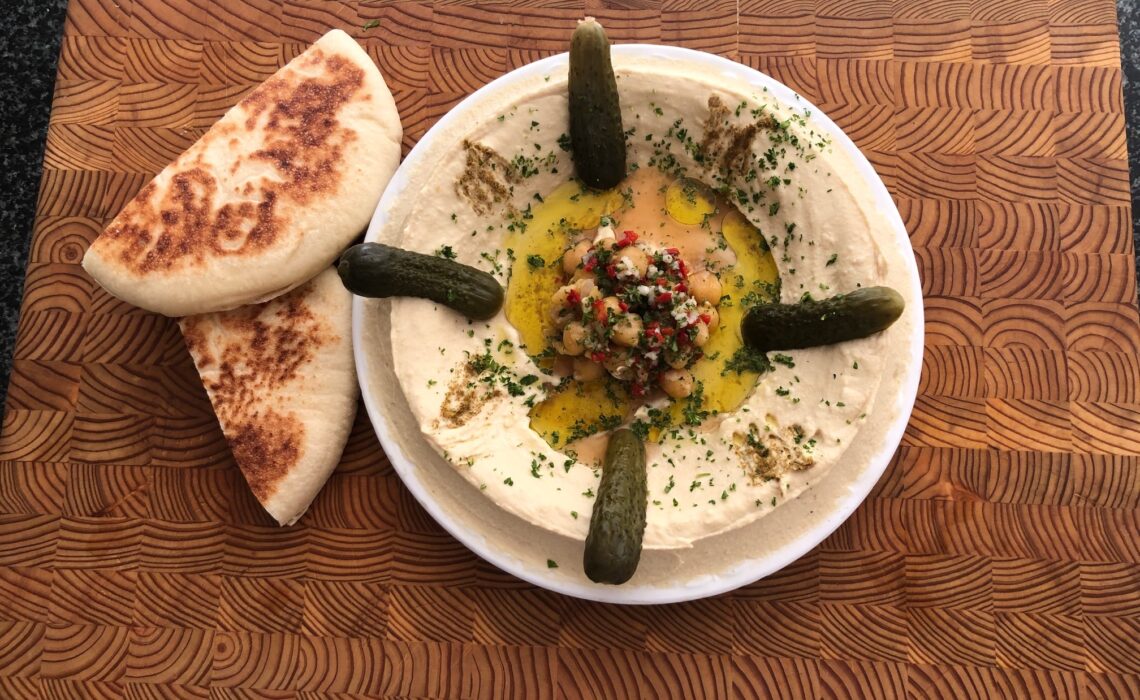
Hummus is perhaps the most popular dish in the Middle East bar none! It is simple, cheap, versatile, and suited for any meal of the day. No mezzeh collection would be authentic without a hummus dish. It can be eaten on its own with flat bread, embellished with pickles, roasted pine nuts, or mince lamb fried in rich ghee. It can also be a side dish, or as a paste in a falafel sandwich. As far as I know, hummus is the only dish named after its principal ingredient, the legume ‘hummus’, the Arabic noun for chickpeas.
Like falafel, hummus was relatively recently discovered by the Western taste buds and being a vegetarian dish, it began a journey of colonisation of supermarket shelves as an exotic dip. Also like falafel, there are so many variants on this simple dish, from the terrible-tasting, mass produced, chemically enhanced for longevity with strange ingredients to the authentic and truly delightful breakfast dip eaten with freshly baked flat bread alongside falafel, cheese, zaatar & olive oil, chased by a hot sweet tea with fresh mint.
It is easy to under-estimate or overlook the protein-rich chickpea as a novelty legume used in making falafel and hummus. This couldn’t be further from the truth. Chickpeas are very popular in Indian cuisine and included in many curries, side dishes, salads and in powdered form as an alternative to flour. In fact, two thirds of the world chickpea production comes from India and has been known to be consumed as part of the staple diet in the Middle and Far East for over 7000 years.
Chickpeas are harvested early when still green and soft, partly for cooking in Indian cuisine, or to be eaten raw or roasted in their light-green translucent pods as snacks, like you would eat roasted peanuts. However, most of the crop is harvested when the chickpeas have matured and turned yellowish white, for consumption when in season or dried for storage for use in a multitude of dishes like hummus. Next time you are offered Bombay Mix, look closely and you will find roasted chickpeas amongst all the other salty snacks. In my view, chickpeas should be considered alongside wheat and rice as the world’s most successful plants that, over the centuries, have insinuated themselves on humanity, to cultivate and grow as the staple food ingredients relied upon to feed billions of us.
Back to our humble hummus dip. There are so many variations on preparing this dip that range from the weird and disgusting to the simple traditional and delicious offering. Without wishing to judge others, I am guilty of meddling with the original concept, hoping to introduce a new level of excellence but in the end, I confess that the simple traditional method is the correct way. Happily, this works well for any of us to prepare and enjoy an excellent dish of hummus, conceived and produced in the comfort of our own kitchens.
To become a hummus legend amongst your circle of friends, here are a few tips that will make your hummus stand out as a palate-seducing, taste bud-tickling food of the sultans:
- Always use the best ingredients from the dried chickpeas (get the fat and light coloured variety), to the other ingredients such as tahini, lemons, and fresh herbs.
- Inspect the dry chickpeas and get rid of the rogue ones that are green, black or small and shriveled. Rinse and soak the chickpeas for a minimum of 12 hours before boiling them.Avoid pre-cooked, tinned chickpeas, they do not give the same taste results as the ones you soak and cook yourself.
- Cook for as long as it is necessary for the chickpeas to be totally soft.If you must speed up the cooking process, you can add a small amount of bicarbonate of soda but, ‘patience’ is very often the most secret ingredient in dishes that many people overlook.
- Depending on how much patience you have, try and fish out the translucent skin of chickpeas when they are 80% to 90% cooked.The skin prevents you from producing really creamy and smooth hummus however, it does not interfere with the overall taste.
- Never prepare your hummus with the newly boiled chickpeas when they are still hot.As a matter of fact, you need to have them cool down and then refrigerated for at least two hours to make them very cold. Very cold chickpeas give you a much lighter coloured and more attractive looking hummus. If you cannot wait for two hours for the chickpeas to cool in the fridge, you can add some ice cubes to the mixture.
- You can use a pestle & mortar, a potato masher or hand-held mixer but in my view, you need a modern fast food mixer with the metal knife attachment to run for at least 5 minutes but preferably 10 minutes or until you have a truly fluffy, creamy, snow-white mixture that needs to be spooned out (not runny like a cake mix that you pour into your mould).
- Hummus consists of FOUR basic ingredients that you must include in the mixture and resist any temptation to add anything else at this stage.You need the cooked and cooled chickpeas, tahini, lemon juice and salt. Nothing else should go in the food processor. If the mixture is way too thick, you can add a little bit of cold water, if too runny, add tahini.
- What you have is very edible dish of hummus and many people like it as it is with a drizzle of extra virgin olive oil on top.However, there is a special hummus dressing I recommend, which can be spooned over the unadulterated hummus and guaranteed to bring out the ‘ooohs’ and ‘aaahs’ from your guests.
- This dressing consists of lemon juice, salt, crushed garlic, ground cumin, chopped hot chili, chopped parsley and/or mint.Pour this dressing over the basic hummus mixture and add a generous drizzle of extra virgin olive oil.
One final thought: Imagine if hummus was a dish commonly known to have come from a European country, large or small. It would have been protected in terms of name and essential ingredients as in Greek Yoghurt, French Roquefort Cheese, Italian Parma Ham, Cyprus Halloumi Cheese, or Portuguese Port. As it is, with many claims to its parentage, who don’t care if it is abused by others, hummus is often compromised and insulted by so many cooks, chefs, factories and supermarkets.
If you would like my detailed hummus recipe, please let me know and I will send you a copy.
Enjoy the real thing!
Mufid Sukkar – May 2020



You’ve done it again Mufid . You made my mouth water especially now I am fasting Ramadan . I can’t wait until Iftar to tryout your recipe. Keep them coming my friend.
Did you hear that police are investigating the death of the chickpea?
Some are saying it’s a likely hummus-ide
XXX